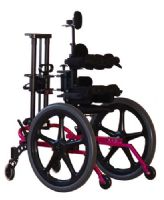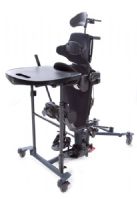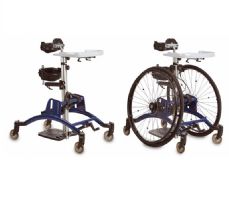 Written by Morgan Hopkins, DPT, CMTPT
Written by Morgan Hopkins, DPT, CMTPT
Pediatric standers, also known as standing frames or adaptive standers, play a vital role in supporting children with mobility challenges by offering improved postural support, muscle strengthening, and enhanced social engagement. These devices are particularly beneficial for children with medical conditions including cerebral palsy, multiple sclerosis, spinal injuries, and muscular dystrophy, which result in differing levels of mobility limitations.
Pediatric Standers are a great solution for overcoming certain limitations, as they enable children to participate in upright positioning and weight-bearing activities safely and comfortably. Remarkably,about 78% of healthcare providers prescribing pediatric standers have observed that their patients experience enhanced bowel and bladder function when using the equipment. By addressing the various needs of these young patients, pediatric standers considerably influence their daily lives and overall well-being.
 | KidWalk II Dynamic Mobility System View Product |
A pediatric stander, also known as an adaptive stander or standing frame, is a specialized adaptive device designed to help children with physical disabilities achieve various positions, including upright, modified prone, and modified supine. This support enhances a child's mobility and addresses challenges associated with conditions that limit independent movement, including constipation, hip dislocation, tight tendons, and loss of muscle strength.
Pediatric standers provide essential support for children with chronic medical conditions that impact their mobility. By spending time in a pediatric stander, children can overcome these challenges and improve their well-being. Standers also help maintain joint flexibility and reduce the risk of contractures which occurs when muscles and tendons around a joint shorten to limit movement. In addition, standers promote better blood circulation, particularly for individuals with limited mobility, by preventing blood pooling in the lower extremities.
Furthermore, standers facilitate better lung expansion and breathing in an upright position, reducing the risk of respiratory infections and complications. They also aid gastrointestinal function by encouraging natural peristalsis and reducing reflux. Beyond the physical benefits, pediatric standers contribute to better social interaction, fostering a sense of independence and improving overall mental health and self-esteem for children with mobility challenges.
Recommended: KidWalk II Dynamic Mobility System
 | EasyStand Bantam Medium Sit-to-Stand Stander - Infinite Positioning View Product |
Cerebral Palsy (CP) is a group of neurological disorders impairing movement, balance, and posture. It is caused by aberrant brain development or brain injury before, during, or shortly after birth. CP is distinguished by variable degrees of motor function impairment, which can severely restrict movement.
Pediatric standers are particularly beneficial for children with cerebral palsy, as they provide crucial support for standing and weight-bearing activities.Using a stander can help these children develop muscle strength, including upper body strength, while also improving balance and standing tolerance. Additionally, standers contribute to better bone health, posture, breathing, digestion, and social interaction. They also help reduce the risk of common mobility-related issues, such as joint contractures and pressure sores.
Recommended: EasyStand Bantam Medium Sit-to-Stand Stander - Infinite Positioning
 | Rabbit-Up Pediatric Stander View Product |
Head and spine injuries refer to damage sustained to the skull, brain, or spinal cord, which can lead to temporary or permanent physical disabilities. Such injuries may result from accidents, falls, or other traumatic events. Individuals with severe head and spine injuries often face limited mobility and prolonged periods of sitting or lying down, which can lead to the development of pressure sores, osteoporosis, and other health complications. Standers play a vital role in the rehabilitation process and overall health of individuals with head and spine injuries. Standers can help them get up and active again, leading to many benefits with rehab and overall health.
Recommended: Rabbit-Up Pediatric Stander
Muscular Dystrophy (MD) is a group of genetic disorders characterized by progressive weakness and degeneration of the skeletal muscles responsible for movement. The severity and progression of symptoms can vary, but individuals with MD often experience difficulties with mobility, muscle strength, and motor function.
While there is no cure for MD, a stander can significantly impact functional mobility and improve the quality of life for those affected. Some of the long-term benefits a stander offers include muscle strengthening, improved posture, increased circulation, and aid in reducing the formation of contractures.
Multiple Sclerosis (MS) is a chronic neurological disorder that affects the central nervous system, including the brain and spinal cord. In MS, the immune system mistakenly attacks the protective covering of nerve fibers, disrupting communication between the brain and the rest of the body. Symptoms of MS vary widely but often involve muscle weakness, coordination and balance issues, and mobility challenges.
Standers are especially advantageous for individuals with MS, as they assist in tackling the mobility and physical challenges related to the condition. The primary benefits of utilizing a stander for people with MS encompass increased bone strength, better range of motion, and enabling users to navigate more independently.
Obtaining coverage for standers from private insurance companies may not always be successful, but Medicaid typically covers them. Standing devices fall under the Durable Medical Equipment (DME) category and are classified as Complex Rehab Technology (CRT). To secure coverage, a Letter of Medical Necessity from a licensed physician is required.
Alternatively, several state and national grants are available to cover pediatric standers, with an increasing number of organizations recognizing them as essential devices. Noteworthy national funds and foundations include Chive Charities, United Healthcare, and Cerner Charitable Foundation. Additionally, many state and local organizations can offer assistance in obtaining standers for children in need.
Pediatric standers play a crucial role in helping children with mobility challenges resulting from various medical conditions, such as cerebral palsy, multiple sclerosis, spinal injuries, and muscular dystrophy. By providing improved postural support, muscle strengthening, and enhanced social engagement, these devices allow children to safely and comfortably participate in upright positioning and weight-bearing activities. The significance of pediatric standers for children with mobility challenges is immense, as they substantially impact their daily lives and overall well-being.
Explore our selection to learn more about pediatric standers and their benefits for children facing mobility challenges. Additionally, visit us at Caregiver University for more resources and support tailored to caregivers.

Morgan Hopkins is a licensed doctor of physical therapy and freelance medical writer. She practiced clinically in outpatient orthopedics for 8+ years specializing in intramuscular dry needling, dance medicine, and post-operative care. Morgan seeks to be a leader in the continued shift toward preventative healthcare, helping people optimize movement now so they can move for years to come. She is a firm believer in complementary therapies, holistic wellness, and functional fitness and is thrilled to be able to educate others through Rehabmart’s platform.